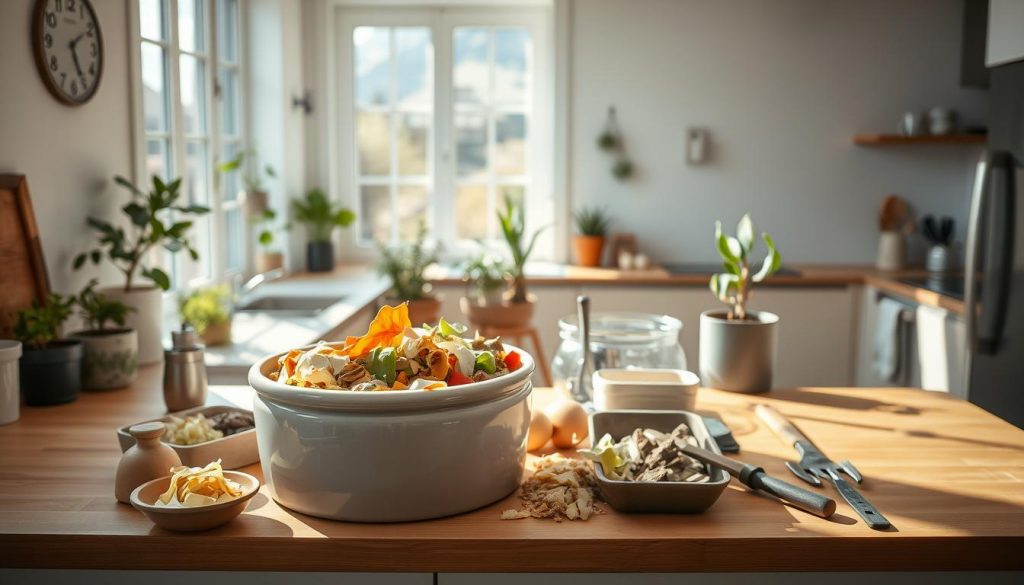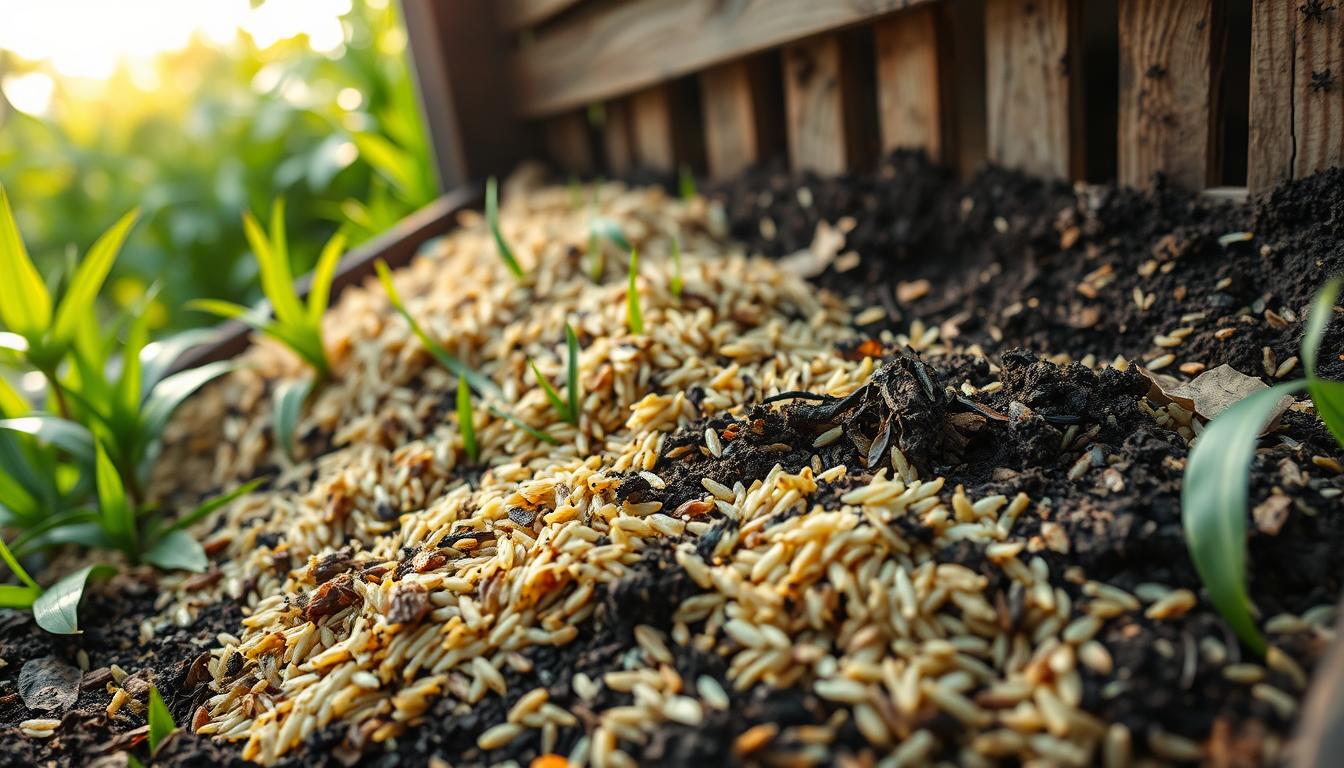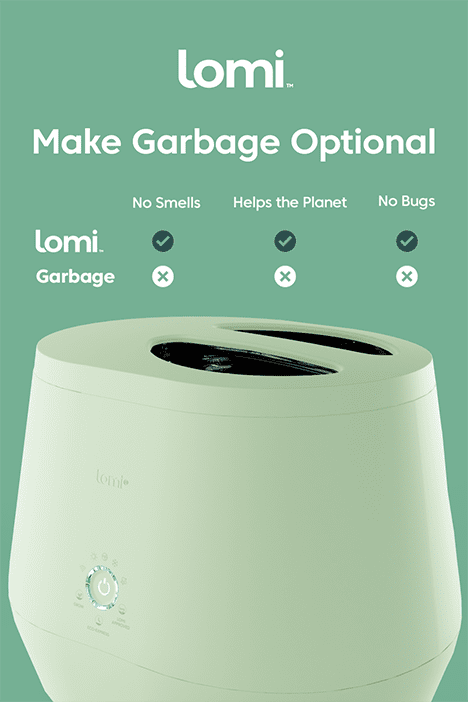As I stand in my kitchen, staring at the leftover rice from last night’s dinner, I’m reminded of the millions of tons of food waste generated every year.
Recent data shows that food waste is a big environmental problem. Finding new ways to deal with it is key.
One method getting more attention is composting food waste, including cooked rice. But is it a good choice?
Composting cooked rice can be good. It cuts down on waste going to landfills and makes soil full of nutrients.
Key Takeaways
- Composting cooked rice is a viable option for reducing food waste.
- It helps in creating nutrient-rich soil for gardening.
- Proper composting techniques are essential for success.
- Composting can significantly reduce the environmental impact of food waste.
- It’s a simple and effective way to contribute to a more sustainable lifestyle.
My Composting Journey: How It All Started
Starting to compost was a big step into sustainable living for me.
I’ve always loved gardening. I saw composting as a way to make kitchen scraps into good soil.
From Gardening Novice to Composting Enthusiast
I began with a few pots on my balcony, growing herbs and veggies. But I knew I needed better soil to grow more.
That’s when I started learning about composting.
I was drawn to the idea of making waste useful for my garden. It seemed like a smart way to improve my gardening.
Why I Decided to Explore Food Waste Composting
I wanted to cut down on kitchen waste. I learned that a lot of trash is food scraps.
Composting seemed like a great way to reduce waste and make good soil.
It’s been a rewarding journey. I’ve learned a lot about being green and managing waste.
| Benefits of Composting | Description |
|---|---|
| Reduces Waste | Composting kitchen scraps reduces the amount of waste sent to landfills. |
| Creates Nutrient-Rich Soil | The composting process turns waste into a valuable resource for gardening. |
| Supports Sustainable Living | By reducing waste and creating a useful product, composting supports sustainable living practices. |
Understanding the Basics of Food Composting
Learning about composting can really help you live more sustainably. It’s a natural way to turn organic waste into a rich soil amendment.
What Makes Good Compost Material
Good compost needs a mix of ‘greens’ and ‘browns.’ Greens are high in nitrogen, like food scraps and grass clippings.
Browns, on the other hand, are rich in carbon, such as dried leaves and newspaper. Mixing both is key for good compost.
The Science Behind Decomposition
Decomposition happens thanks to tiny microorganisms eating organic matter. The right mix of nitrogen and carbon, and active microbes, are essential.
Nitrogen and Carbon Balance
It’s important to have the right carbon-to-nitrogen ratio.
Aim for 2/3 ‘browns’ and 1/3 ‘greens.’ This balance helps things break down well.
Microbial Activity in Compost
Microbes like bacteria and fungi do the work of breaking down waste. They need moisture, oxygen, and the right temperature to thrive.
| Compost Material | Carbon/Nitrogen Content | Examples |
|---|---|---|
| Greens | High Nitrogen | Food scraps, grass clippings |
| Browns | High Carbon | Dried leaves, straw |
Knowing these basics can make your composting better. It turns waste into something great for your garden.
Can You Compost Cooked Rice? My Experience
When I started composting, I wondered if cooked rice could be composted.
This question is key for those trying to cut down on food waste but aren’t sure about composting cooked foods.
The Traditional Warnings Against Composting Cooked Foods
Many gardening experts advise against composting cooked foods, like rice. They worry it might attract pests and cause bad smells.
The main worry is that cooked rice can draw rodents and other pests, which could infest the compost pile.
Cooked rice is also thought to be a place for bacteria and mold to grow. This can harm the composting process if not handled right.
What Actually Happened When I Tried It
I decided to try composting cooked rice, despite the warnings. I started with small amounts to see how my compost would react.
My First Attempt with Small Quantities
I added a small amount of cooked rice to my compost, mixing it with leaves and vegetable scraps. The first results were good, with no pests or bad smells right away.
Scaling Up: Adding More Rice Over Time
Seeing good results, I added more cooked rice to the compost.
I balanced it with dry leaves and turned the compost often to avoid risks.
Here’s what I noticed over time:
| Quantity of Cooked Rice | Pest Attraction | Odor Issues | Compost Quality |
|---|---|---|---|
| Small | No | Minimal | Good |
| Moderate | Some | Occasional | Satisfactory |
| Large | Yes | Noticeable | Poor |
By being careful with how much cooked rice I added, I successfully composted it without major problems.
The Potential Concerns with Composting Cooked Rice
Composting cooked rice can be a great way to cut down on waste. But, there are a few things to think about to make sure it works well.
One big worry is that cooked rice might attract pests. But, with the right steps, you can avoid this problem.
Pest Attraction: Myths vs. Reality
The idea that cooked rice draws pests is not entirely wrong. But, it’s often made bigger than it is. Pests are more drawn to messy compost piles than to the rice itself. To keep pests away, it’s key to:
- Keep the compost pile balanced with the right mix of materials
- Put cooked rice deep in the pile
- Turn the pile often to keep it well-aired
Mold and Bacteria Considerations
Cooked rice can grow mold and bacteria if not mixed right. It’s important to make sure the compost pile gets hot enough to kill these germs.
A good compost pile should get between 130°F and 140°F.
Odor Management Challenges
Composting cooked rice can also lead to bad smells. But, you can control this by balancing the materials and keeping the pile aired.
Adding dry stuff like leaves or straw helps soak up moisture and cut down on smells.

By tackling these issues, composting cooked rice can be a great way to reduce waste and make rich soil.
Best Practices for Composting Cooked Rice
To compost cooked rice well, knowing what affects its breakdown is key. It’s a great way to cut down on kitchen waste and make soil for your garden.
But, you need to watch the compost pile closely to keep it balanced.
Proper Ratios: Balancing Browns and Greens
Getting the right mix of ‘browns’ and ‘greens’ is crucial. Browns are dry, like leaves, and greens are wet, like food scraps.
Aim for 2/3 browns and 1/3 greens. This mix helps the compost break down well and keeps pests away.
When adding cooked rice, balance it with browns. Layer your pile with browns at the bottom, greens in the middle, and browns on top.
Burial Method: Keeping Rice Hidden in Your Pile
Burying cooked rice in the pile is a good practice. It keeps pests away and prevents bad smells. This way, the rice breaks down fast and helps the compost pile stay healthy.
Rhonda Sherman, a composting expert, says burying food waste deep in the pile speeds up breakdown and cuts down on odors.
This works best when you turn the pile often.
Temperature Management for Successful Decomposition
Keeping the compost pile warm is important. It should be between 130°F and 140°F to kill off bad stuff.
Turning the pile regularly helps keep it at the right temperature.
Hot Composting Techniques I Use
To hot compost, my pile is big enough (at least 3x3x3 feet), moist, and turned often.
This method works well for composting cooked rice and other kitchen scraps.
Seasonal Adjustments for Optimal Results
Seasonal changes affect composting. In cold months, keep the pile warm and moist. In hot months, watch the temperature to avoid overheating.
| Season | Composting Tips |
|---|---|
| Winter | Insulate the compost pile, maintain moisture |
| Summer | Monitor temperature, ensure adequate aeration |
By following these tips, you can make a compost that’s good for your garden and cuts down on kitchen waste.
My Composting Setup for Kitchen Scraps
As I started composting, I learned how crucial a good setup is. I bought the right tools and created a routine that fits my life.
Good organic waste management begins with the right composting system.
The right tools and a steady routine are key to turning scraps into compost.
The Equipment I Use
I have a few essential pieces for composting. First, I use a compost bin made for kitchen scraps. I’ve tried many, but a traditional bin works best for me.
My Compost Bin Setup
I chose a traditional bin for its ventilation and easy access. It helps manage odors and pests. Plus, it keeps rodents out, which is a big plus.
Tools That Make the Process Easier
Along with the bin, I have some tools to help. A compost turner is great for mixing the pile and speeding up breakdown.
I also use an aerator to make sure oxygen gets everywhere.
My Weekly Maintenance Routine
I check my compost pile every week. I look at moisture, turn it, and add new stuff as needed.
I also watch the temperature to keep it right for decomposition.
Sticking to this routine helps me make great compost. It’s good for my garden and cuts down on waste.

Beyond Rice: Other Cooked Foods in My Compost
I found out that many cooked foods can be composted, cutting down my kitchen waste a lot. This made me see new ways to handle my household waste better.
Expanding my composting, I saw many cooked foods could be reused.
This reduced landfill waste and made my garden compost richer.
Pasta, Bread, and Other Grains
Cooked pasta, bread, and grains can go into the compost. They add carbon, balancing the compost’s nitrogen.
But, mix them well with other compost to avoid pest problems.
Cooked Vegetables and Leftovers
Cooked veggies and leftovers are great for composting. They’re full of nutrients and enrich the soil when broken down.
Chop them up and mix with ‘brown’ materials like dried leaves or straw.
What I Still Avoid Composting
Even though I compost more, I still skip meat, dairy, and oily foods. They attract pests and smell bad. Keeping a balanced compost pile is crucial.
To show the balance in my compost, here’s a simple table:
| Material Type | Examples | Nutrient Value |
|---|---|---|
| Grains | Cooked pasta, bread | Carbon-rich |
| Vegetables | Cooked vegetables, leftovers | Nitrogen-rich |
| Browns | Dried leaves, straw | Carbon-rich |
Troubleshooting Common Issues I’ve Faced
My journey with composting cooked rice showed me how to tackle common problems. Composting is simple, but challenges can pop up if not handled right.

Dealing with Unwanted Visitors
One big issue I faced was pests like rodents and flies. But, I found that a balanced compost pile keeps them away.
Regularly turning the compost and keeping it just right helps too.
Addressing Slow Decomposition
Slow decomposition is a problem, especially in cold weather. I keep an eye on my compost pile’s temperature.
Adding more “greens” or using a compost accelerator speeds things up.
Managing Seasonal Challenges
Seasonal changes affect composting too. In winter, decomposition slows down. To fix this, I insulate my compost pile with straw or leaves. In summer, I make sure it doesn’t dry out.
Knowing these issues and acting early keeps my composting on track.
Using sustainable composting methods cuts down waste and makes my garden soil better.
The Environmental Impact of Composting Cooked Foods
Composting cooked foods can greatly reduce environmental waste. As I’ve composted cooked rice and other foods, I’ve seen its big impact.
It’s not just about reducing waste; it’s about making a difference for our planet.
Reducing Landfill Waste: My Personal Contribution
Composting cooked foods keeps waste out of landfills. This action cuts down on methane, a harmful greenhouse gas.
The Environmental Protection Agency (EPA) says food waste is a big problem in landfills. Composting helps solve this issue.
Reducing landfill waste is key to managing organic waste. Composting cooked foods is a big part of this effort.
Creating Rich Soil for My Garden
Composting cooked foods makes my garden soil rich and full of nutrients. This boosts soil health and helps plants grow well.
Nutrient Cycling in My Garden Ecosystem
By composting, I cycle nutrients back into my garden. This cuts down on the need for synthetic fertilizers. It also keeps my garden ecosystem balanced.
Reduced Need for Commercial Fertilizers
This method also means I use fewer commercial fertilizers.
These fertilizers can harm the environment because of how they’re made and transported.
Alternative Methods I’ve Tried for Disposing of Cooked Rice
I’ve looked into new ways to deal with cooked rice waste. I’ve learned that there are many ways to handle kitchen scraps like cooked rice.
Bokashi Fermentation: A Complementary Approach
Bokashi fermentation is a cool method that’s catching on. It involves fermenting kitchen waste, like cooked rice, in a special environment.
It’s great for dealing with cooked foods that are hard to compost.
It’s easy to do: just layer kitchen scraps with bokashi bran in a container. The microbes in the bran break down the waste, making a liquid fertilizer.
My Worm Bin Experiments
I tried worm composting, or vermicomposting, with cooked rice. I put red wiggler worms in a special bin.
They eat the rice and make good compost.
Comparing Results with Traditional Composting
I compared bokashi and worm composting to regular composting. Bokashi and worm composting are better at controlling smells and pests.
But, they need more setup and care than regular composting.
Some benefits of these methods are:
- Less smell and pests
- Compost is more nutrient-rich
- Can compost more types of kitchen waste
Now, I mix traditional composting with bokashi and worm composting. This mix works best for managing cooked rice and other kitchen waste.
My Results: How Cooked Rice Has Affected My Compost Quality
Through my composting journey, I’ve found that cooked rice boosts compost quality. It has made a big difference in my compost pile.
Soil Texture and Nutrient Content
Adding cooked rice to my compost has made the soil better for roots. Experts say, “Composting organic materials like cooked rice can enhance soil’s water-holding capacity and aeration.”
My soil now holds moisture better and is more crumbly.
The compost’s nutrient content has also improved. Cooked rice adds carbon, which, mixed with nitrogen-rich greens, makes the compost rich in nutrients.
This is shown by the increased earthworm activity and the health of my compost ecosystem.
Plant Growth Observations
My plants have grown well with the rice-enriched compost. They have shown vigorous growth and improved resistance to pests and diseases.
This is thanks to the compost’s better nutrient profile.
Before and After Comparisons in My Garden
Looking at my garden before and after using the rice-enriched compost has been eye-opening. My plants used to lack nutrients but now they’re thriving.
As a gardening expert says,
“Compost is the single most important soil amendment you can make.”
Specific Plants That Thrived with Rice-Enriched Compost
Some plants have really benefited from the improved compost. My tomato plants, for example, have grown exceptionally well and produced a lot.
My leafy greens have also grown faster and look healthier.
Conclusion: My Verdict on Composting Cooked Rice
Composting cooked rice is good for the environment. It helps reduce food waste, making our lives more sustainable.
This simple act can make a big difference.
With the right mix of materials and care, cooked rice can be composted well. This method cuts down on landfill waste.
It also makes soil better for gardens.
Adding cooked rice composting to our routines helps the planet. The facts back up its benefits. It’s a small step towards a greener future.






